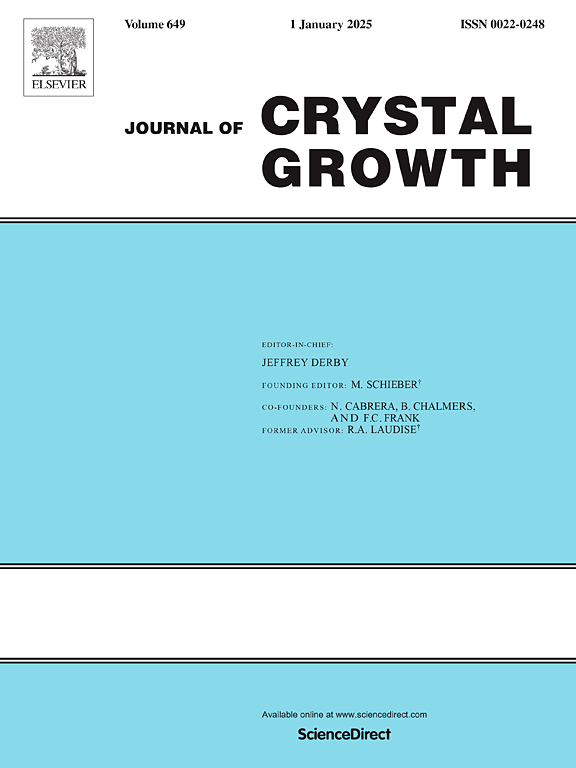Detailed study of HVPE-GaN doped with silicon
IF 1.7
4区 材料科学
Q3 CRYSTALLOGRAPHY
引用次数: 0
Abstract
The purpose of this work was to optimize the silicon doping process in gallium nitride grown using the halide vapor phase epitaxy method. Five crystal growth experiments were carried out to investigate the influence of reagent flow on the incorporation of the donor dopant. Additionally, the study examined the role of growth morphology, which was found to significantly affect the uniformity of silicon incorporation and free carrier distribution in the crystals. Crystals in this work were grown on native ammonothermal substrates of high structural quality. Silicon was the only intentional donor dopant introduced into the growth zone in the form of gaseous precursor, dichlorosilane. The structural quality, concentrations of incorporated dopants and free carriers, were analyzed for each grown crystal. The results indicated that silicon was the only electrically active, statistically relevant dopant in all of the samples. The rate of hydrogen chloride flow in the dichlorosilane line was correlated with the final concentration of silicon in the samples. The silicon and free carrier concentrations of up to 1019 cm−3 were noted. Silicon incorporation appeared to be non-uniform regardless of the growth conditions. Each sample exhibited a gradient of silicon and free carrier concentrations along the growth direction. It was shown that the cause of silicon gradient in gallium nitride crystals was associated with the silicon deposition inside the reactor, in the dichlorosilane line, as well as with the crystal’s growth morphology.
掺硅hpe - gan的详细研究
本工作的目的是优化卤化物气相外延法生长氮化镓中的硅掺杂工艺。进行了5次晶体生长实验,考察了试剂流动对供体掺杂剂掺入的影响。此外,研究还考察了生长形态的作用,发现生长形态对晶体中硅掺入均匀性和自由载流子分布有显著影响。本研究中的晶体是在高结构质量的天然氨热基质上生长的。硅是唯一以气态前体二氯硅烷的形式引入生长区的供体掺杂剂。对每个生长晶体的结构质量、掺杂剂和自由载流子的浓度进行了分析。结果表明,硅是所有样品中唯一的电活性,统计相关的掺杂剂。氯化氢在二氯硅烷生产线上的流动速率与样品中硅的最终浓度相关。硅和自由载流子浓度高达1019 cm−3。无论生长条件如何,硅的掺入都是不均匀的。每个样品沿生长方向表现出硅和自由载流子浓度的梯度。结果表明,氮化镓晶体中硅梯度的产生与反应器内硅的沉积、二氯硅烷线以及晶体的生长形态有关。
本文章由计算机程序翻译,如有差异,请以英文原文为准。
求助全文
约1分钟内获得全文
求助全文
来源期刊

Journal of Crystal Growth
化学-晶体学
CiteScore
3.60
自引率
11.10%
发文量
373
审稿时长
65 days
期刊介绍:
The journal offers a common reference and publication source for workers engaged in research on the experimental and theoretical aspects of crystal growth and its applications, e.g. in devices. Experimental and theoretical contributions are published in the following fields: theory of nucleation and growth, molecular kinetics and transport phenomena, crystallization in viscous media such as polymers and glasses; crystal growth of metals, minerals, semiconductors, superconductors, magnetics, inorganic, organic and biological substances in bulk or as thin films; molecular beam epitaxy, chemical vapor deposition, growth of III-V and II-VI and other semiconductors; characterization of single crystals by physical and chemical methods; apparatus, instrumentation and techniques for crystal growth, and purification methods; multilayer heterostructures and their characterisation with an emphasis on crystal growth and epitaxial aspects of electronic materials. A special feature of the journal is the periodic inclusion of proceedings of symposia and conferences on relevant aspects of crystal growth.
 求助内容:
求助内容: 应助结果提醒方式:
应助结果提醒方式:


